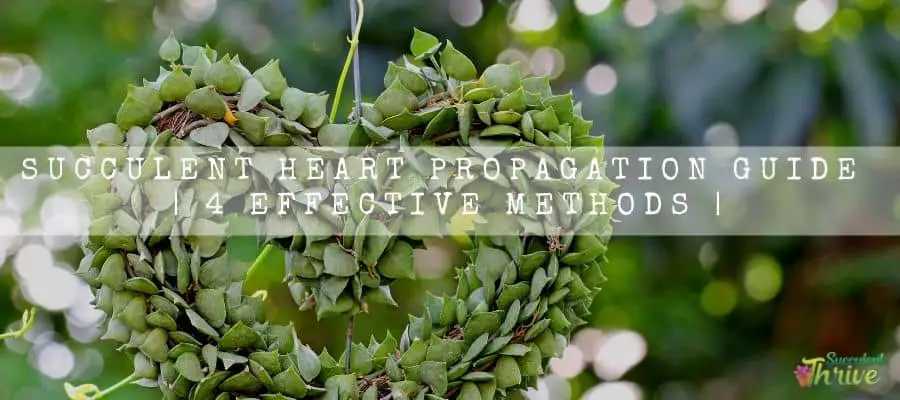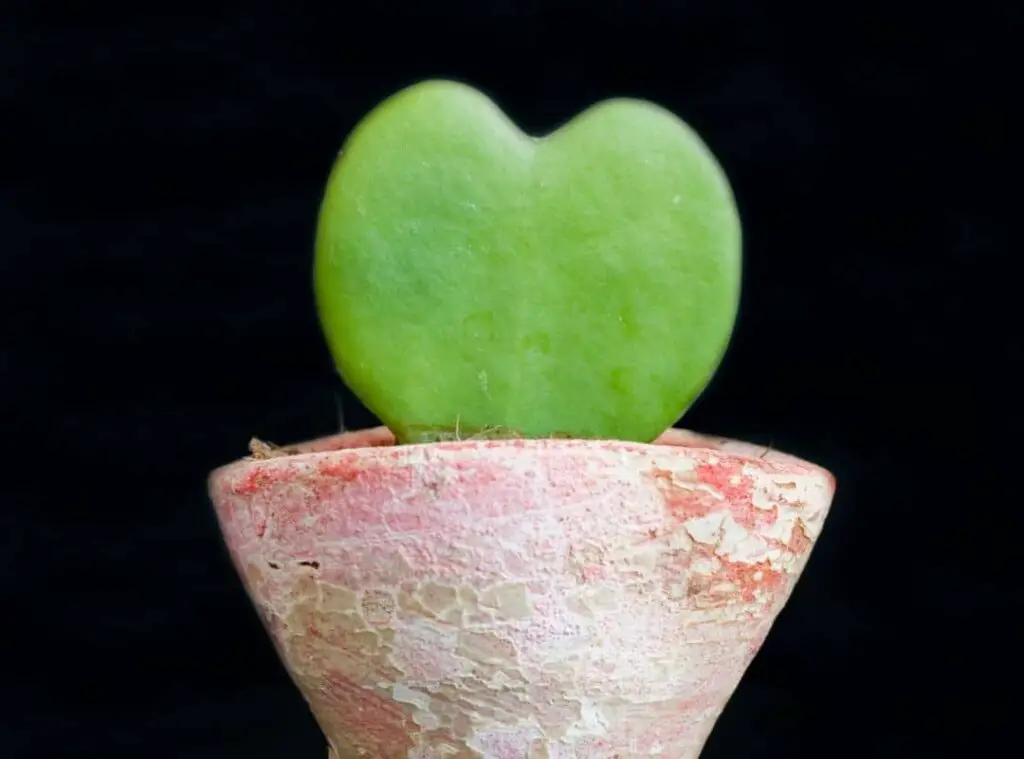We can conduct succulent heart propagation via several methods. They are by using leaves, vine cuttings etc.
To briefly touch on the Hoya hearts, they are so popular worldwide as great house plants. In addition to that many people use this as a perfect gift item.
They have inherited some common names such as valentine Hoya, sweetheart plant due to their heart shaped leaves.
They are native plants in southeast Asia. Further, they require a minimum care and if you fulfill their basic growing conditions, they will thrive well.

Succulent heart propagation by leaf cutting
You could conduct the leaf cutting method to propagate these plants. However, you need to conduct the propagation during early spring when they finished their growing season.
Using ziploc bag
First, you need to take the cuttings which have a few nodes. As aforesaid, nodes will be forming roots and when you obtain cuttings with nodes that will give you most reliable results.
Further when you obtain the leaf cutting, make the cutting slightly below the stem. After that you could place it in a Ziploc bag which you have filled with a soil medium. Ensure that the nodes are fully covered with soil.
After that I would encourage you to spray some water which will help to enhance the humidity level in the bag.
Once you finished spraying water you could blow into the bag and seal it afterwards. Finally, you could place it near a lighting source.
Using sphagnum moss
Just like in the Ziploc method, you need to obtain leaf cuttings which have a few nodes. You could place them in a pot which you have filled with a pre-moistened sphagnum moss.
After that try to squeeze water as much as you can in the moss. Once you place the leaf cutting make sure that the stem part is wrapped with moss.
Further ensure that at least 1/3 of the leaf is covered with moss. That will help them to stay established in the moss.
Further, when they form roots, it will help them to stand stable too. After that you could start spraying some water.
Using Perlite
This is a new way of propagating the Hoya plants. You need to use a leaf cutting which has a few nodes for this method as well.
You could arrange a pot with perlite when doing this. This is in fact a passive hydroponic way of propagating them.
Make sure that the pot is at least 1/3 of water filled. However, avoid making the moss waterlogged.
Next, you could place the leaf cutting in perlite. When you do this, ensure that 1/ 3 of the leaf is covered in perlite.
That will help them to stay stable in the pot when they form roots. This will be a pretty way of propagating the plants.

Succulent heart propagation by Stem cuttings
If you are looking for an easy way of propagating the Hoya Kerrii, you could consider using the vine cutting method. Steps are as follows.
- First obtain a vine of 2’ to 3 ‘size. Make sure that it has at least one or two leaves.
- After that, dip the cut edges in some honey so that it will avoid any potential bacterial infection. You could use cinnamon instead of honey too.
- Next you may leave those cuttings in a dry place where they can wither. That will allow those cut edges to be callous.
- You may see the plant vine consist of small, raised bumps. Those are the nodes of the plant, and they would form aerial roots of the plant. Those nodes will form roots when you propagate them in the soil and in water.
- Consider that you are propagating them in water, then you need to oxygenate the water for 24 hours one day prior to the propagation. To do that you could use 1 tsp of hydrogen peroxide to 1 cup water. Make sure that you are changing the water on a frequent basis when you conduct the propagation through water. That will simply avoid any potential root rot.
- On the other hand, if you are using soil as their growing medium, you need to use a light damp soil medium. Further you need to expose them for humidity until the root formation takes place.
- I would encourage misting the specimen several times a day. Alternatively, you could cover it loosely with a plastic bag. Make sure that the bag is not in touch with the vine or the leaves of the cutting.
- Keep the cuttings under your observation for a few weeks’ time so that you could see whether all parts of the cuttings are healthy.
- In case, if you spot any discoloration, check whether there are any root rots. If you spot any rotten areas, you need to cut them off until you spot the white sap.
- After that you could treat them with a fungicide. You may consider changing the potting medium too. It will take about 14-18 days to show the results.
- Continue with the regular care treatment for the specimen. When you spot, they have formed ½ inch or more new roots, you could pot them up in a new pot which you have filled with loose soil medium. You may see the results of the transplant within one months’ time.
Do they produce seed
These plants produce seeds. You could spot their seeds in their seed pods. When those seeds ripe, seed pots will split, and disperse.
You can use those seeds to grow a new plant but it is a very slow and hard process.
Can you root Hoya in water?
Hoyas can root in water. To do that, you need to first take a pair of clean scissors and cut off a piece of vine.
Make sure that it has a couple of leaves and one node also. After that you could place those cuttings in a jar.
Place the jar at room temperature. Start watering them until one node is under the water. As aforesaid those nodes will be forming roots and it is important that you do not submerge the leaves.
Once you complete all these, keep the jar somewhere it gets bright indirect sunlight. Change the water once a week.
When you spot the leaves are a few inches in length, you could consider moving them into a permanent pot.

How to treat after propagation
Sunlight
Expose the Hoya plants for bright and indirect sunlight. However do not expose them for direct sunlight as it causes sunburns in the plant.
Having said that, do not expose them for low light levels also. It is important that you expose them for bright sunlight for a few hours since that will help them to maintain their unique color.
Watering
It is important that you let these plants dry out between two watering sessions. Further , they do not expect you to water them frequently since their leaves could conserve water.
Having said that, do not let the leaves wrinkle either. If you spot any wrinkled leaves, that literally means the plant is too dry.
Best is to place your finger in the potting medium so that you could see whether your plant is too dry or whether you need to wait a little more to water them.
If you practice that way, it will help you to avoid any potential root rots.
Humidity
Hoya plants are semi succulents and native in dry deserts. However, they would still require moderate humidity levels.
Pots
Best is to grow them in terra cotta pots. Alternatively, you may use plastic or glazed ceramics. No matter what pot you use, you need to always make sure that it has enough draining holes.
In case, if you are using a pot which does not have enough draining holes, that will cause waterlogged situations in the pot.
That will ultimately lead to root rot. Further, always go ahead with a clean pot or hanging basket.
Potting mix
Hoya plants usually grow in an epiphytic manner which means they would prefer to grow on the surface of another tree.
This literally means the Hoya roots would require a good airflow. Further it has to be a well-draining soil mix as well.
Best is to use a well-draining indoor plant potting mix or a cacti succulent potting mix for them. Moreover, you may consider adding orchid barks or perlite so that it will avoid the mix becoming compacted.
Fertilizing
Hoya plants are a slow growing plant. They are not heavily dependents of fertilizers. Having said that, you could use a water-soluble houseplant fertilizer when feeding them.
However, you need to dilute it to half strength and then use. You could feed them once a month during their growing season which is spring and summer.
Avoid overfeeding these plants. Further avoid feeding them during their dormancy too.
Conclusion
Hope you could improve your knowledge on how to conduct the propagation of the succulent hearts.
So why wait, hurry up and start propagating these wonderful plants and make many more !
Read Next : Rat Tail Cactus Propagation | 2 Effective Methods For You |
Read Next : Flaming Katy Propagation Guide | 3 Effective Methods |
Read Next : Can You Propagate A Panda Plant? | 2 Effective Ways |
